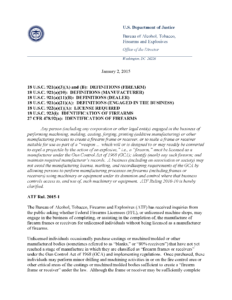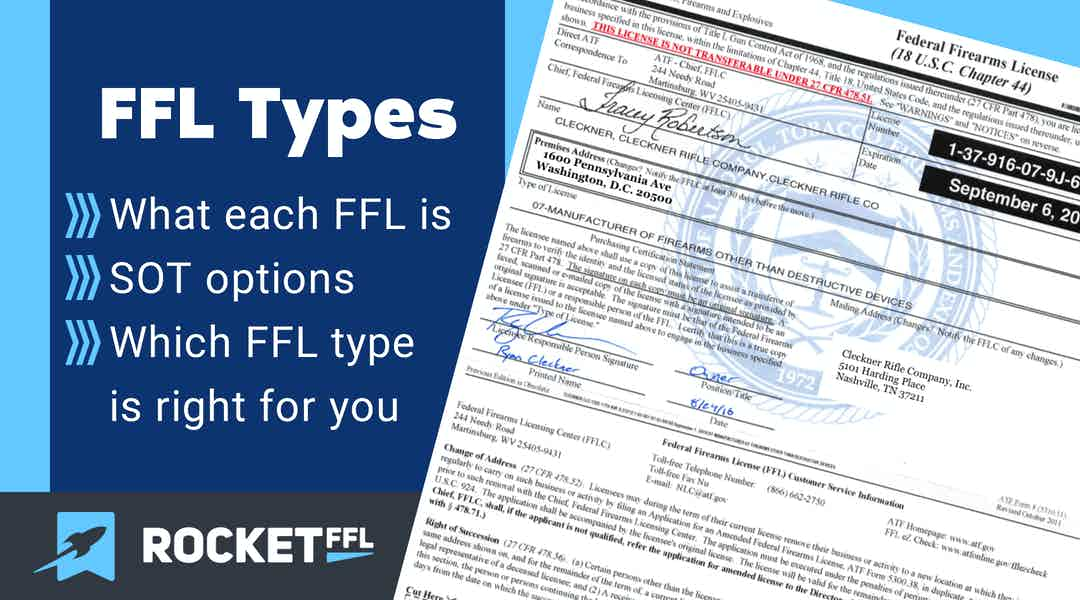There a different types of FFL to choose from. Make sure you understand which FFL type is best for you.
ATF Ruling 2015-1
ATF Ruling 2015-1 was published by the ATF on January 2, 2015. You can view, download, and save the PDF of ATF Ruling 2015-1 by clicking on the image of the ruling. For your convenience, I have also included the full text of the ruling in this update.
Summary:
Any business which allows customers to manufacture firearms on equipment under the business’s control must hold a valid manufacturing FFL and must obey all associated requirements of manufacturing firearms.
Background:
This ruling is in response to the increase in popularity of “80% Receiver” build kits. The term “80% Receiver,” which is not an accurate nor official term, refers to manufactured material that has not yet crossed the line into becoming a firearm. The act of converting an “80% Receiver” into a firearm by completing the manufacturing process constitutes the “manufacture” of a firearm. Prior to conversion into a firearm, “80% Receivers” are not regulated as firearms – they are effectively paperweights.
If you are “engaged in the business” of manufacturing firearms, then you need to have a valid manufacturer’s Federal Firearm License (FFL) and you must comply with the relevant requirements of being an FFL manufacturer (records, firearm markings, etc.). If you are making the firearm for yourself, however, and you do not have an intent to sell it, then federal law allows you to manufacture the firearm without a manufacturer’s FFL and without needing to follow the associated requirements. (This, of course, only applies to a firearm that you’d legally be allowed to possess. Certain firearms are not lawful to possess under your state’s laws or federal law, and certain “prohibited persons” are not allowed to possess firearms. Also, your state’s laws may regulate this activity.)
Certain organizations (businesses or groups/associations of people) were allowing individuals to convert “80% receivers” into a firearms using machinery or equipment owned or controlled by the organization. Some of these organizations did not have manufacturer FFLs and did not follow the requirements for firearm manufacture because they did not believe they were “engaged in the business of manufacturing firearms.” Instead, some organizations felt that they were only engaged in the business of renting machinery and it was up to the individual who was renting and using the machine to determine how they would use the machine.
ATF Ruling 2010 allows dealer-gunsmith FFLs to repair, modify, embellish, refurbish, or install parts in or on firearms for a manufacturer FFL without requiring the dealer-gunsmith FFL to get a manufacturing license as long as the firearms are properly marked by the manufacturer FLL, they aren’t owned by the dealer gunsmith FFL, and they are returned to the manufacturer FFL once the work is done.
Definitions:
“Engaged in the business” means, as applied to a manufacturer of firearms, “a person who devotes time, attention, and labor to manufacturing firearms as a regular course of trade or business with the principal objective of livelihood and profit through the sale or distribution of the firearms manufactured.” 18 U.S.C. § 921(a)(21)(A)
“Dealer-gunsmith” means someone “engaged in the business of repairing firearms or of making or fitting special barrels, stocks, or trigger mechanisms to firearms.” 18 U.S.C. § 921(a)(11)(B)
What the ATF Said:
The conversion of an “80% Receiver” into a firearm is not one of the specific processes that ATF Ruling 2010-10 allows a dealer-gunsmiths to do without a manufacturing license. Also, allowing the newly formed firearm to go directly to the individual who used the business’s machinery to make the firearm violates the requirement of ATF Ruling 2010-10 that the firearm be transferred only between FFLs “who are involved in the manufacturing process” and returned directly to a manufacturing FFL. Therefore, ATF Ruling 2010-10 does not allow a dealer-gunsmith FFL (or any other entity) to be involved in the business of manufacturing firearms without a manufacturer’s license and without complying with the specific requirements placed on manufacturer FFLs.
ATF Ruling 2015-1:
18 U.S.C. 921(a)(3)(A) and (B): DEFINITIONS (FIREARM)
18 U.S.C. 921(a)(10): DEFINITIONS (MANUFACTURER)
18 U.S.C. 921(a)(11)(B): DEFINITIONS (DEALER)
18 U.S.C. 921(a)(21)(A): DEFINITIONS (ENGAGED IN THE BUSINESS) 18 U.S.C. 922(a)(1)(A): LICENSE REQUIRED
18 U.S.C. 923(i): IDENTIFICATION OF FIREARMS 27 CFR 478.92(a): IDENTIFICATION OF FIREARMSAny person (including any corporation or other legal entity) engaged in the business of performing machining, molding, casting, forging, printing (additive manufacturing) or other manufacturing process to create a firearm frame or receiver, or to make a frame or receiver suitable for use as part of a “weapon … which will or is designed to or may readily be converted to expel a projectile by the action of an explosive,” i.e., a “firearm,” must be licensed as a manufacturer under the Gun Control Act of 1968 (GCA); identify (mark) any such firearm; and maintain required manufacturer’s records. A business (including an association or society) may not avoid the manufacturing license, marking, and recordkeeping requirements of the GCA by allowing persons to perform manufacturing processes on firearms (including frames or receivers) using machinery or equipment under its dominion and control where that business controls access to, and use of, such machinery or equipment. ATF Ruling 2010-10 is hereby clarified.
ATF Rul. 2015-1
The Bureau of Alcohol, Tobacco, Firearms and Explosives (ATF) has received inquiries from the public asking whether Federal Firearms Licensees (FFL), or unlicensed machine shops, may engage in the business of completing, or assisting in the completion of, the manufacture of firearm frames or receivers for unlicensed individuals without being licensed as a manufacturer of firearms.
Unlicensed individuals occasionally purchase castings or machined/molded or other manufactured bodies (sometimes referred to as “blanks,” or “80% receivers”) that have not yet reached a stage of manufacture in which they are classified as “firearm frames or receivers” under the Gun Control Act of 1968 (GCA) and implementing regulations. Once purchased, these individuals may perform minor drilling and machining activities in or on the fire control area or other critical areas of the castings or machined/molded bodies sufficient to create a “firearm frame or receiver” under the law. Although the frame or receiver may be sufficiently complete to be classified and regulated as a “firearm,” it generally requires substantial additional machining before it can accommodate fire control components such as a trigger, hammer, or sear and be used to expel projectiles. For instance, a casting of an AR-15 type receiver can be machined using common power tools so that it reaches a stage of manufacture that it would be classified as a “firearm frame or receiver,” yet incapable of being assembled into a weapon that will expel projectiles. Unlicensed individuals propose to take either a blank, or a frame or receiver (not marked with a serial number or any other marks of identification) to a licensed dealer-gunsmith or machine shop for further machining and finishing so that it can be assembled into a complete or functional firearm as designed. The FFLs or unlicensed machine shops would then use their own equipment, such as a Computer Numeric Controlled (CNC) machine or other means, to finish the blank or frame or receiver into one that can be used to assemble a weapon capable of firing projectiles.
The GCA, 18 U.S.C. § 921(a)(1), defines a “person” to include “any individual, corporation, company, association, firm, partnership, society, or joint stock company.” Section 921(a)(10), defines a “manufacturer” as any person engaged in the business of manufacturing firearms or ammunition for purposes of sale or distribution. As defined by section 921(a)(21)(A), the term “engaged in the business” means, as applied to a manufacturer of firearms, “a person who devotes time, attention, and labor to manufacturing firearms as a regular course of trade or business with the principal objective of livelihood and profit through the sale or distribution of the firearms manufactured.” Because “manufacturing” is not defined by the GCA, courts have relied on the ordinary meaning of the word, including actions to “make a product suitable for use.” See, e.g., Broughman v. Carver, 624 F.3d 670, 675 (4th Cir. 2010). Section 921(a)(11)(B) defines a “dealer,” in relevant part, as any person engaged in the business of repairing firearms or of making or fitting special barrels, stocks, or trigger mechanisms to firearms.” A person meeting this definition is commonly referred to as a “gunsmith.”
Section 921(a)(3), defines a “firearm,” in relevant part, as both a “weapon … which will or is designed to or may readily be converted to expel a projectile by the action of an explosive” (921(a)(3)(A)), and the “frame or receiver of any such weapon” (921(a)(3)(B)). Under section 923(i), licensed manufacturers must identify each firearm manufactured by a serial number in the manner prescribed by regulation. Federal regulations at 27 CFR 478.92(a)(1) add that “a licensed manufacturer … must legibly identify each firearm manufactured … [b]y engraving, casting, stamping (impressing), or otherwise conspicuously placing … an individual serial number” on the frame or receiver, and certain additional information – the model (if designated), caliber/gauge, manufacturer’s name, and place of origin on the frame, receiver, or barrel. Regulations further require the serial number to be at a minimum depth and print size, and the additional information to be at a minimum depth. Additionally, the serial number must be placed in a manner not susceptible of being readily obliterated, altered, or removed, and not duplicate any serial number placed by that manufacturer on any other firearm.
In ATF Ruling 2010-10 (approved December 27, 2010), ATF advised that licensed dealer- gunsmiths (type 01) may legally perform certain firearm manufacturing activities if specified conditions were met. Specifically, that ruling held that licensed gunsmiths could conduct such manufacturing activities if the firearms were: (1) not owned, in whole or in part, by the dealer- gunsmith; (2) returned by the dealer-gunsmith to the importer or manufacturer upon completion of the manufacturing processes, and not sold or distributed to any person outside the manufacturing process; and (3) already properly identified / marked by the importer or manufacturer in accordance with Federal law and regulations.
ATF Ruling 2010-10 is based on two distinct but related premises. First, it recognizes that there are specific activities traditionally performed by gunsmiths, i.e., repairing, modifying, embellishing, refurbishing, installing parts, or specialized finishing of functional frames or receivers. Such activities do not include, and the Ruling does not directly address the machining or other manufacturing processes required for the frame or receiver to be created or any steps to make it suitable for use in assembling a “weapon … which will or is designed to or may readily be converted to expel a projectile by the action of an explosive.” Second, the Ruling recognizes that, by transferring the firearm only to another FFL involved in the manufacturing process, there is no “sale or distribution of the firearm manufactured” requiring a manufacturer’s license.
Machining or Other Manufacturing of Frames or Receivers
Because the GCA contains distinct definitions of “firearm,” one can be a manufacturer of a “frame or receiver,” and also a “weapon … which will or is designed to or may readily be converted to expel a projectile by the action of an explosive” that incorporates that frame or receiver. See Broughman, 624 F.3d at 676 n.4 (“That Broughman manufactures ‘firearms’ within the meaning of one statutory definition rather than another does not render him any less a manufacturer of ‘firearms’ within the meaning of the Act.”) ATF Ruling 2010-10 assumes that licensed dealer-gunsmiths would perform certain activities on articles already classified as frames or receivers (i.e., no machining or other processes required to allow it to be used to assemble a weapon), such as assembly and applying special coatings and treatments. Implicit is the understanding that the manufacture of the frame or receiver was completed (for example, having an existing fire-control cavity), and it was marked by a licensed manufacturer in accordance with Federal law and regulations.
However, when a person performs machining or other manufacturing process on a blank to make a firearm “frame or receiver,” or on an existing frame or receiver to make it suitable for use1 as part of a “weapon … which will or is designed to or may readily be converted to expel a projectile by the action of an explosive,” that person has performed a manufacturing operation other than what is contemplated by the GCA of dealer-gunsmiths, i.e., persons described by section 921(a)(11)(B) as “engaged in the business of repairing firearms or of making or fitting special barrels, stocks, or trigger mechanisms to firearms.” In this context, “machining or other manufacturing process” includes making a frame or receiver, or taking any of the steps to make an existing frame or receiver functional – that is, suitable for use as part of a weapon that will expel a projectile by the action of an explosive.2 For example, in an AR-type weapon, “machining or other manufacturing process” would include any activity that creates a fire- control-cavity as designed. Although such an article may be classified as a “receiver” when it is indexed, machining or other manufacturing process takes place to create a receiver when material is actually removed from the cavity so that the fire-control-components may actually be installed.
1 See Broughman at 675 (“[T]he plain and ordinary meaning of the word ‘manufacture’ is ‘to make into a product suitable for use.’” (quoting Merriam-Webster Online Dictionary (2010)) Consequently, the GCA required a manufacturer’s license where a gunsmith assembled firearms from component parts.)
2 For purposes of this Ruling, activities associated with tapping and mounting a scope are considered neither “machining” nor a “manufacturing process.”The activities discussed in ATF Ruling 2010-10 are not the manufacturing processes to create the firearm frame or receiver, or any of the steps that allow the frame or receiver to function when assembled into a complete weapon on behalf of non-licensed individuals. To the contrary, those gunsmithing activities are explicitly required to be done on behalf of a licensed manufacturer or importer who are required by 27 CFR 478.92(a)(2) to mark and serialize the frame or receiver prior to shipment to the gunsmith. As explained by the ruling, “[t]his will ensure that the frames or receivers can be traced by ATF in the event they are lost or stolen during the manufacturing process.” This distinction is also legally significant because manufacturing processes that create essential features, depending on the type of firearm, are necessary for the frame or receiver to function as part of a complete “weapon.” At this stage of production, the frame or receiver is different from one that a licensed gunsmith may receive and perform gunsmithing services because these manufacturing processes make the frame or receiver suitable for use in assembling a “weapon” under the GCA.
Distribution of Firearms Manufactured
Once the manufacturing processes have occurred and a frame or receiver has been made, however, to require licensing as a manufacturer, a person must still be engaged in the business through the “sale or distribution” of the firearms manufactured. ATF Ruling 2010-10 interpreted this phrase to exclude the transfer of firearms between Federal firearms licensees who are involved in the manufacturing process. The Ruling held, in part, that because the firearms manufactured were not “sold or distributed,” the contracted gunsmiths did not satisfy this statutory requirement for licensing as manufacturers. Rather, that Ruling expressly prohibits licensed gunsmiths from distributing firearms outside the manufacturing process and requires them to be returned to the licensed manufacturer that initially produced and marked the frame or receiver. Underlying this analysis is the fact that the GCA provides special privileges to FFLs involved in firearms transactions with other FFLs. These include the authority to transfer firearms interstate, and to transfer firearms without a background check or completion of ATF Forms 4473 (Firearms Transaction Records). In light of this, no “distribution” occurs when a licensed manufacturer sends firearms to another FFL who performs contracted manufacturing activities and returns them.
ATF Ruling 2010-10 does recognize that gunsmiths may improve firearms by participating in the manufacturing process. However, none of the enumerated processes (i.e., repairing, modifying, embellishing, refurbishing, installing parts, or specialized finishing) actually create a frame or receiver, or make an existing frame or receiver suitable for use in assembling a “weapon” capable of expelling a projectile. This is consistent with the traditional services that gunsmiths offer. Generally, licensed gunsmiths perform actions in repairing or improving firearms that are already complete weapons, or capable of being assembled as such. Gunsmiths do not perform the machining or other manufacturing processes to create frames or receivers, or make them suitable for use in assembling a weapon that can expel a projectile.
Although licensed gunsmiths return firearms to their customers after performing the contracted work, the GCA does not consider this to be a sale or distribution of the firearms manufactured. This is because the returned firearm has only been repaired or temporarily received for custom work – it has not been machined in a manner or otherwise created or made suitable for use as part of a weapon. However, when a licensed gunsmith takes in a frame or receiver to perform machining or other manufacturing process, that gunsmith “distributes” a firearm to the customer upon return because that manufacturing activity results in the making of a different “frame or receiver” and also a “weapon … which will or is designed to or may readily be converted to expel a projectile” – both defined separately as a “firearm” under the GCA.
Further, permitting a licensed gunsmith to perform manufacturing processes on a frame or receiver on behalf of an unlicensed person would lead to an absurd result. If the above mentioned activities were permitted, firearms could be legally manufactured without any markings or serialization by dealer-gunsmiths who could avoid licensing as a manufacturer simply because his/her customer is unlicensed. For example, instead of purchasing marked and serialized receivers or complete weapons from licensed dealers, individuals might purchase unregulated castings or machined/molded bodies from a supplier, perform a minor machining or other operation sufficient to create a “firearm frame or receiver,” contract with a gunsmith to perform necessary and substantial machining operations, and then assemble a complete weapon without marks of identification or records of production. Such activity runs contrary to a major purpose of the GCA in that it eliminates the ability of law enforcement to trace firearms used in crime, or stolen or lost firearms.
Use of Manufacturing Machines, Tools, or Equipment
An FFL or unlicensed machine shop may also desire to make available its machinery (e.g., a computer numeric control or “CNC” machine), tools, or equipment to individuals who bring in raw materials, blanks, unfinished frames or receivers and/or other firearm parts for the purpose of creating operable firearms. Under the instruction or supervision of the FFL or unlicensed machine shop, the customers would initiate and/or manipulate the machinery, tools, or equipment to complete the frame or receiver, or entire weapon. The FFL or unlicensed machine shop would typically charge a fee for such activity, or receive some other form of compensation or benefit. This activity may occur either at a fixed premises, such as a machine shop, or a temporary location, such as a gun show or event.
A business (including an association or society) may not avoid the manufacturing license, marking, and recordkeeping requirements under the GCA simply by allowing individuals to initiate or manipulate a CNC machine, or to use machinery, tools, or equipment under its dominion or control to perform manufacturing processes on blanks, unfinished frames or receivers, or incomplete weapons. In these cases, the business controls access to, and use of, its machinery, tools, and equipment. Following manufacture, the business “distributes” a firearm when it returns or otherwise disposes a finished frame or receiver, or complete weapon to its customer. Such individuals or entities are, therefore, “engaged in the business” of manufacturing firearms even though unlicensed individuals may have assisted them in the manufacturing process.
Held, any person (including any corporation or other legal entity) engaged in the business of performing machining, molding, casting, forging, printing (additive manufacturing) or other manufacturing process to create a firearm frame or receiver, or to make a frame or receiver suitable for use as part of a “weapon … which will or is designed to or may readily be converted to expel a projectile by the action of an explosive,” i.e., a “firearm,” must be licensed as a manufacturer under the GCA; identify (mark) any such firearm; and maintain required manufacturer’s records.
Held further, a business (including an association or society) may not avoid the manufacturing license, marking, and recordkeeping requirements of the GCA by allowing persons to perform manufacturing processes on blanks or incomplete firearms (including frames or receivers) using machinery, tools, or equipment under its dominion and control where that business controls access to, and use of, such machinery, tools, or equipment.
Held further, this ruling is limited to an interpretation of the requirements imposed on persons under the GCA, and does not interpret the requirements of the National Firearms Act, 26 U.S.C. 5801 et. seq.
Recommended Posts




